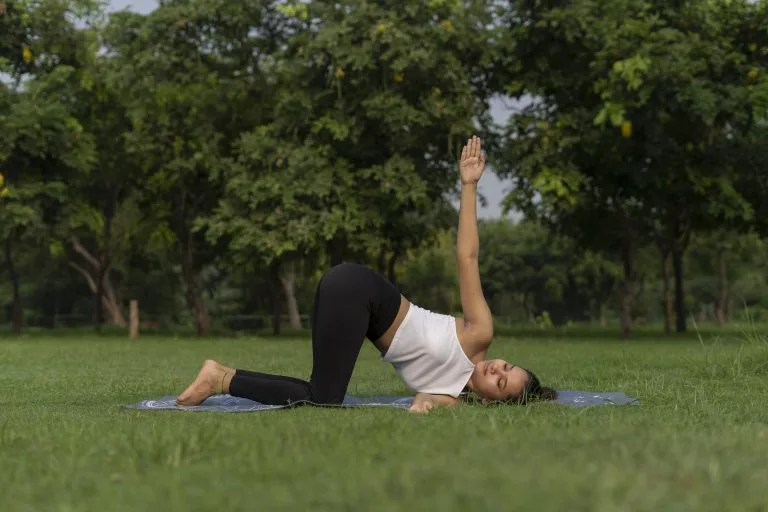Yoga is an ancient practice that has been around for thousands of years. This form of exercise has been gaining popularity in recent years due to its many health benefits. Yoga combines physical postures, breathing exercises, and meditation to promote overall health and wellness. In this article, we will explore the physical benefits of yoga and how it can improve your health and well-being.
1. What is Yoga?
Yoga is a practice that originated in ancient India and involves physical postures, breathing exercises, and meditation. It is a holistic approach to wellness that integrates the mind, body, and spirit. The physical postures or asanas are designed to promote physical strength, flexibility, and balance, while the breathing exercises or pranayama aim to improve respiratory function and reduce stress. Meditation or dhyana helps to calm the mind, reduce anxiety, and promote inner peace.
2. Physical Benefits of Yoga
Yoga offers a wide range of physical benefits that can improve your health and wellbeing. Here are some of the most significant benefits of practicing yoga regularly:
Improves Flexibility
Yoga postures are designed to stretch and strengthen muscles, tendons, and ligaments. Regular practice can improve flexibility and range of motion, making it easier to perform everyday activities and preventing injuries.
Builds Strength
Many yoga postures require you to support your body weight, which can help build muscular strength and endurance. Practicing yoga regularly can also increase bone density and reduce the risk of osteoporosis.
Increases Balance and Coordination
Yoga postures that require you to balance on one leg or arm can improve your balance and coordination. These skills are essential for preventing falls and maintaining independence as you age.
Reduces Pain and Inflammation
Yoga can reduce pain and inflammation by improving circulation, reducing stress hormones, and releasing tension in the muscles. It has been shown to be effective in treating chronic pain conditions such as arthritis, fibromyalgia, and back pain.
Boosts Immune System
Yoga can boost the immune system by increasing the production of antibodies and activating immune cells. It also reduces stress hormones that can weaken the immune system.
Enhances Respiratory Function
Yoga breathing exercises or pranayama can improve respiratory function by increasing lung capacity, reducing breathlessness, and improving oxygenation of the blood. This can benefit people with respiratory conditions such as asthma and COPD.
Lowers Blood Pressure and Heart Rate
Yoga can lower blood pressure and heart rate by reducing stress hormones and promoting relaxation. This can reduce the risk of cardiovascular diseases such as hypertension and heart disease.
Improves Digestive System
Yoga can improve digestive function by reducing stress and tension in the body, promoting relaxation and better digestion. Certain yoga poses can also stimulate the digestive system and help alleviate digestive issues such as constipation and bloating.
The practice of yoga can also promote a healthy gut microbiome, which is essential for optimal digestion and overall health. Studies have shown that regular yoga practice can increase the production of beneficial gut bacteria and improve gut function.
Promotes Weight Loss
Yoga can promote weight loss by increasing metabolism, burning calories, and reducing stress hormones. It can also improve body awareness, making you more mindful of your eating habits and food choices.
3. Best Yoga Poses for Physical Benefits
Here are some of the best yoga poses for physical benefits:
Downward Dog
Downward Dog is a classic yoga pose that stretches the hamstrings, calves, and spine. It also strengthens the arms, shoulders, and wrists.
Warrior II
Warrior II is a powerful standing pose that builds strength in the legs, hips, and core. It also stretches the groin and chest.
Tree Pose
Tree Pose is a balancing pose that improves stability and focus. It also strengthens the legs, hips, and core.
Triangle Pose
Triangle Pose is a standing pose that stretches the hamstrings, hips, and spine. It also strengthens the legs and core.
Cobra Pose
Cobra Pose is a backbend that strengthens the back muscles and improves spinal flexibility. It also stretches the chest and shoulders.
Child’s Pose
Child’s Pose is a resting pose that stretches the hips, thighs, and ankles. It also promotes relaxation and relieves stress.
Bridge Pose
Bridge Pose is a backbend that strengthens the back, glutes, and legs. It also stretches the chest and neck.
Plank Pose
Plank Pose is a core-strengthening pose that also strengthens the arms, shoulders, and wrists. It also improves posture and balance.
Sun Salutation
Sun Salutation is a sequence of poses that warms up the body and stretches all major muscle groups. It also improves circulation and respiratory function.
4. Tips for Starting a Yoga Practice
If you’re new to yoga, here are some tips for starting a practice:
- Find a qualified yoga teacher or studio
- Start with a beginner-friendly class or video
- Wear comfortable clothing and bring a yoga mat
- Listen to your body and don’t push beyond your limits
- Practice regularly for the best results
5. Precautions and Contraindications
While yoga is generally safe for most people, there are some precautions and contraindications to keep in mind. If you have any medical conditions or injuries, talk to your doctor before starting a yoga practice. Avoid or modify poses that cause pain or discomfort. If you’re pregnant, consult with your doctor or a prenatal yoga teacher before practicing yoga.
6. Conclusion
Yoga is an excellent form of exercise that offers many physical benefits. It can improve flexibility, build strength, increase balance and coordination, reduce pain and inflammation, boost the immune system, enhance respiratory function, lower blood pressure, and heart rate, improve digestive function, and promote weight loss. With regular practice and proper guidance, anyone can enjoy the physical benefits of yoga.
Related Article: Mental Benefits of Yoga: Stress Relief and More
Related Article: Yoga and Diet: How to Combine Them for Effective Weight Loss
7. FAQs
Is yoga only for flexible people?
No, yoga is for anyone regardless of their flexibility level. It is a practice that can help improve flexibility over time.
How often should I practice yoga?
It depends on your goals and schedule. Ideally, practicing yoga 2-3 times per week can provide significant physical benefits.
Can yoga help with weight loss?
Yes, yoga can promote weight loss by increasing metabolism, burning calories, and reducing stress hormones.
Can yoga be harmful?
Yoga is generally safe for most people. However, if you have any medical conditions or injuries, talk to your doctor before starting a yoga practice.







